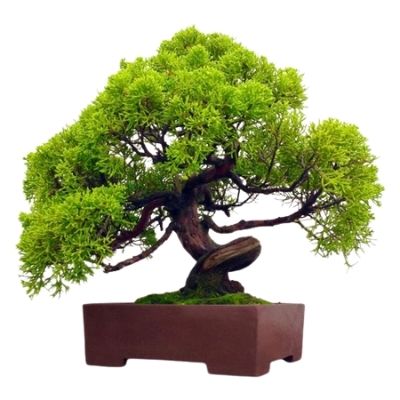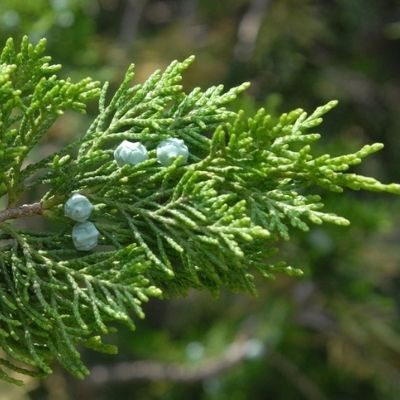
Chinese Juniper
(Juniperus chinensis)
Country of Origin : China and Mongolia
Bonsai Styles : Informal upright, cascade, group
Zone : 5 – 9
The trunks and branches of these tough trees are knobbly, rough, and twisted, with large areas of “driftwood” exposed.
Generally speaking, this habit is one of the highly sought after habits in bonsai tree styling.
Chinese juniper bonsai tree provides ample opportunities to create unique styles of jins (stripped and bare part of branch) and sharis (part of trunk with no bark) , as long as there is adequate amount of foliage on the bonsai tree to sustain its life.
Chinese juniper bonsai tree is a bushy evergreen tree. The young foliage is needle like (specially in the inner sections of the bonsai tree). As the foliage matures, the foliage attains a more scale like shape with dark green color.
The bark of Juniperus chinensis bonsai tree peels away easily, and is reddish brown in color. When lightly brushed, the bark gives off a beautiful reddish hue. This pairs beautifully with the lush green foliage and the silvery-white jins.
Chinese juniper tree also produces small flowers which eventually turn into bluish black color fruits.

Best location to keep Chinese Juniper Bonsai
The foliage of Junipers grows neatly and compactly under full sun.
Chinese juniper bonsai tree also does well in semi shade. In partial shade, the color of the foliage will be richer. However, in shade, the growth of the Chinese juniper bonsai tree is slow in spring.
Shade will also protect the bonsai tree from extreme cold and hot temperature variations.
In all temperate regions of Europe, the Chinese juniper bonsai tree does not require special protection in winter.
However, they should not be considered hardy in North America. It is advisable to move plants into a frost-free shed during winter when temperatures drop below 14°F (-10°C).
Chinese juniper bonsai tree does not need to be protected from frost.
Winter winds may turn the foliage bronze, but the leaves will turn green again in spring.
Refer sunlight requirements for indoor plants for more indoor plant placement ideas.
Propagation of Chinese Juniper
Chinese juniper tree can be propagated with stratified seeds in spring.
It can also be propagated in summer using softwood cuttings.
Watering Chinese Juniper Bonsai
In spite of being drought-tolerant, junipers can soak up large amounts of water.
During the growing season, water the Chinese juniper bonsai tree well.
In spring and early summer, you should water your bonsai once a day; by midsummer, you should water twice a day.
Water once a day towards the end of summer and into fall.
It is best to keep the soil just moist in winter.
Do not allow the soil to become waterlogged and do not let it completely dry out.
Wiring Chinese Juniper Bonsai
Chinese juniper bonsai tree can be wired in between early spring and fall.
Make sure that you do not catch any foliage under the wire.
The wires should not be left on the Chinese juniper bonsai tree for more than one year.
Pruning Chinese Juniper Bonsai
When to prune Chinese juniper bonsai?
How to prune Chinese juniper bonsai?
The main branches of a Chinese juniper do not need to be removed unless the tree needs to be reshaped.
In case you are trying to reshape the bonsai tree, the woody growth should be cut back, however be careful not to cut through the foliage since this will brown the tips.
The main goal of pruning Chinese juniper bonsai tree is to keep the foliage structure compact and dense. To achieve this, make sure not to let the young shoots to grow longer than needed.
Late summer is a good time to prune the old shoots and branches of Chinese juniper bonsai tree. Because late summer is the time when the sap content of the tree is not typically rising, hence reducing the chances of ‘bleeding’ of the tree while pruning.
Pinching Chinese Juniper Bonsai
Pinching can be done from early spring to fall to hold the intended style of the Chinese juniper bonsai tree.
To keep a neat outline, pinch down all the growing tips with your fingers.
To cut back or remove aggressive extension shoots, they should be cut as close to a healthy side shoot as possible.
Make sure the undersides of branches are free of foliage.
Repotting Chinese Juniper Bonsai
When to repot Chinese juniper bonsai?
Repotting of Chinese juniper bonsai tree can be done in early to mid spring.
Repot Chinese juniper bonsai tree every 2 years. However, when the tree becomes 10 years old, you can repot the Chinese juniper bonsai tree every 5 years or so.
If the roots still have room to expand in the bonsai pot, do not repot the tree.
When repotting, do not prune more than 1/3 of the roots.
You can use a soil mix mixed with 20% finely chopped fresh sphagnum moss
OR
You can also use one part humus or peat, one part Akadama and two part coarse sand.
OR
You can also use equal parts of coarse sand, leaf mold and loam.
Must Read: Bonsai Soil Recipes
Must read : Choosing the right bonsai container
Feeding Chinese Juniper Bonsai
Apply a high-nitrogen fertilizer early in the spring. Apply fertilizer every two throughout the summer months until fall.
OR
For the growing season, use a balanced feed; for the autumn, apply a nitrogen-free feed. Spring growth can be strengthened with an additional dose of slow-release balanced feed in mid-winter.
Diseases and pest of Chinese Juniper Bonsai
As with all the other juniper bonsai trees, spider mites, scaled insects and caterpillars can pose some problems. If not able to remove by hands, use systemic insecticide.
Congested foliage can sometimes be attacked with fungal infections. For this, you can use systemic fungicide.
Chinese Juniper bonsai tree is vulnerable to sap sucking insects.
It is generally possible to remove aphids and scale insects with a jet of water, however if an infestation is severe apply a systemic insecticide.
Chinese Juniper bonsai care
The junipers turn yellow or brown when exposed to frost. While it is not aesthetically pleasing, it does not harm the tree.
The bonsai will turn green again when spring arrives.
Chinese Juniper branches are notorious for taking a long time to set after wiring. Several factors make Juniper bonsai the most time-consuming to grow, including the springy, resinous heartwood, the relatively thin layers of xylem that are deposited every year, and the unusual longevity of the tree.
Newly-set branches (≤ 5 mm) on young trees can take up to two years to set. However, older branches may never set.
In Japan, it is not uncommon to see Chinese juniper bonsai exhibits with wired branches.
In healthy Chinese juniper bonsai tree, the foliage needs to be thinned periodically and the outline reconstructed as new shoots constantly emerge from branch intersections.
Junipers shed their leaves on a regular basis in the wild in order to keep a balance between the efficiency of roots and the needs of leaves. This will also happen when the Chinese juniper bonsai tree is in a bonsai container.
What to look for when buying Chinese Juniper Bonsai
Look for a tree which has series of curves. These curves should not have any acute and sharp bends. Sharp turns in the trunk does not look natural in Chinese juniper bonsai tree.
Try to buy a younger plant. As wiring and shaping older branches is not easy. Wire training a younger tree is relatively easy.


1 comment
I was recommended this blog by my cousin. I’m not sure whether this post is written by him as no one else know such detailed about my difficulty. You’re wonderful! Thanks!